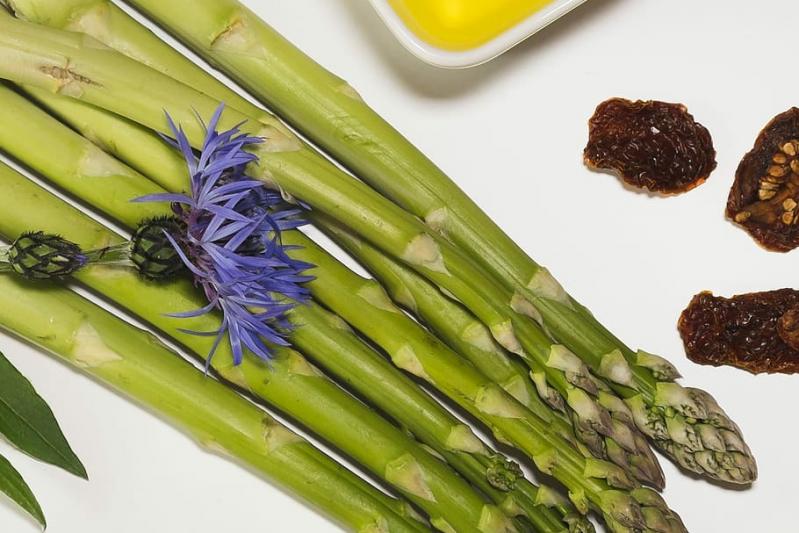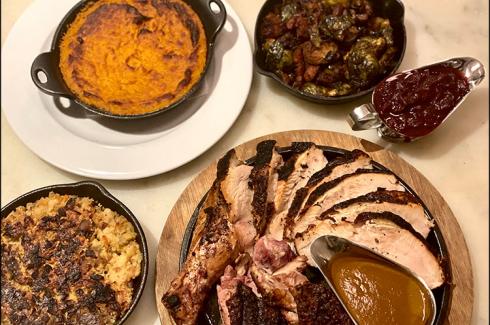Asparagus are the crocuses of vegetables, the very first edible herald of spring. Of course, like most exotic luxuries, asparagus can be seen in fancy food shops as early as the January white sales.
All vegetables seem now to have reached the apogee of social acceptance and their once humble role as something to fill in around the main event, or even to fill up those who disdain animal food, is almost forgotten.
Asparagus and artichokes, for which it is high season in April and May, never suffered that sort of indignity; they always had cachet and for that reason have been accorded the respect of a separate course. They just may be among the very few foods that it’s still socially correct to eat with the fingers.
Spirited debates continue on the relevant tastiness of white or green asparagus (Europeans prefer white and Americans green) and in this country, on which size stalks are superior. I rather imagine that a preference for tiny, skinny asparagus may be boosted by the fond wish that they require no peeling.
“The best asparagus is peeled asparagus, and I don’t know why it is often so difficult to convince beginning cooks of that obvious fact” writes Julia Child in “From Julia’s Kitchen,” one of the books no kitchen should be without.
She points out that a peeled spear cooks evenly in half the time of an unpeeled spear and is toothsome from tip to butt end. Mrs. Child also cooks her asparagus as I do: flat, lying in a deep oval roaster full of salted, boiling water.
These techniques I learned through trial and error a regrettably long time before I read her excellent advice and have been haranguing my readers to go and do likewise for years. However, no cooking authority in our burgeoning mass of them carries more weight in their opinions than The Divine Miz Julia. So, please, peel those stalks after cutting off the woody ends.
When buying asparagus be on the lookout for shriveled ends or opened heads — those are signs of having been cut a long, long time ago. When you get your asparagus home, cut off half an inch from the bottom, stand them in an inch of tepid water in a pitcher, cover with a plastic bag, and refrigerate your treasure. They will keep perfectly for several days.
Unless you’re cooking masses of it, there’s no need to tie asparagus in bundles — just have it all facing the same end of the roaster. The fresh tender peeled asparagus is done usually after the water has returned to the boil for about two minutes. I lift a spear on a kitchen fork and, if it bends slightly, pronounce it done.
The asparagus should immediately be lifted out of the water with a very wide spatula or gently wielded tongs and laid on a dish cloth or napkin to drain. (If the asparagus is to be held for a few hours, it should be refreshed in ice water before draining.)
They are now ready to be eaten — with melted butter or a sauce, or at room temperature with a vinaigrette dressing.
Asparagus With Egg Sauce
This is one of the simplest and most enjoyable ways to eat beautiful spring asparagus. The “sauce” is nothing but a soft-boiled egg — a “jumbo” for each person simmered about 4 minutes and served in an egg cup with a bit of the top peeled.
Butter the asparagus and lay it on a plate with the egg at one side and a little salt and fresh ground pepper in reach. Eggs and asparagus have a natural affinity for each other, which may be the reason asparagus hollandaise has never lost its popularity.
A sauce Maltaise, which is almost identical to hollandaise except that it is flavored with orange juice and zest, is another great pairing with warm asparagus. Actually, asparagus must be served on very warm plates because keeping it really hot is impossible without overcooking it. Do not, however, fall into the “better safe than sorry” trap of cooking asparagus too little and serving what Julia has always referred to as “hot raw” vegetables.
Cream of Asparagus Soup
I consider this one of the most elegant soups in my repertory. And before letting the word “cream” scare off the fatconscious, let me assure you that it contains very little cream, though its texture is as smooth as silk. I do use boiled potatoes to thicken quite a few of my soups, but they lend a graininess that doesn’t complement asparagus. So I tried out the very old French technique of thickening the soup with rice — various bisques are thickened to a gossamer smoothness with a sort of panade of seriously overcooked rice, pureed and pushed through a sieve. Makes two quarts.
1 lb. fresh, green fat asparagus spears
3 Tbsp. unsalted butter
1/2 cup shallots, finely minced
1/2 cup white rice, any kind, but short grain is best for this
1 qt. chicken broth, degreased
1 cup asparagus water
1 cup milk
Salt and white pepper to taste
1/4 cup heavy cream
1 Tbsp. minced fresh parsley
Prepare the asparagus as outlined above. Beginning at the butt end, which has been trimmed of its tough end, slice the asparagus into thin rounds all the way up to the tips. Cook the asparagus in not too salty water until tender — a bit longer than if serving the spears whole. Reserve a cup of the water and about a dozen tips.
Meanwhile (before preparing the asparagus) cook the rice in the chicken broth for 30 or 40 minutes, then puree it in a blender and strain the mixture through a fine sieve.
Puree the cooked asparagus and combine it with the rice, broth, and milk. Taste for seasoning and add white pepper and more salt if needed. Heat to just under the boil and stir in about half of the cream.
Divide the soup among warm bowls and trickle a bit of the remaining heavy cream over the back of the spoon to make a little “s” design on each serving. Sprinkle with a tiny bit of parsley.
Raw Asparagus
Adherents to the raw food movement (who would not have gotten this far down the page in any case) will find little comfort here. Although I have indeed tasted asparagus just cut from the bed at the Green Thumb in Water Mill, and it was okay, but not nearly as good as after I took it home to a hot water blanching.
A brief plunge into boiling water, then into ice water, intensifies the color and flavor of nearly all vegetables. Some, like carrots and spinach, do not even release their nutrients until lightly cooked. Eat all the raw carrots and spinach your palate desires, but don’t think you’re getting many vitamins out of them.
When composing the inevitable crudités platter for spring parties later on, try to include some surprises: very thin slices of raw young turnips or kohlrabi in addition to the more usual blanched asparagus, broccoli, and early slender green beans.
Long before any real tomatoes can be picked locally, the little grape tomatoes are ripe and luscious. Raw cauliflower and fennel are some good choices for winter vegetables. A good homemade mayonnaise flavored with lemon and its rind, or curry spices or Japanese wasabi will be appreciated with anything on the crudités offerings.





